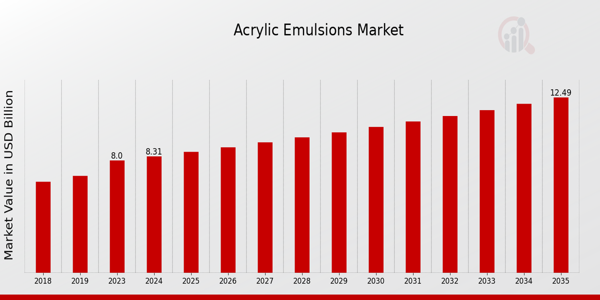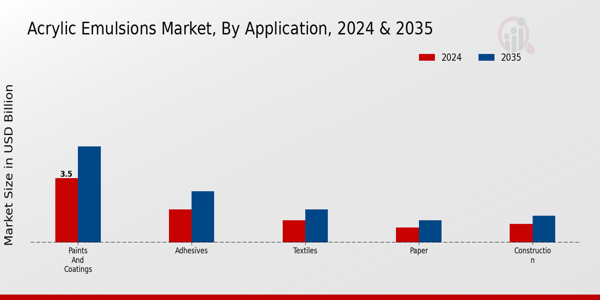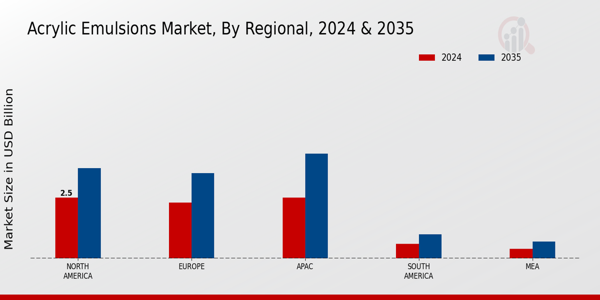Acrylic Emulsions Market Overview
The Acrylic Emulsions Market Size was estimated at 8.0 (USD Billion) in 2023. The Acrylic Emulsions Industry is expected to grow from 8.31(USD Billion) in 2024 to 12.5 (USD Billion) by 2035. The Acrylic Emulsions Market CAGR (growth rate) is expected to be around 3.78% during the forecast period (2025 - 2035).
Key Acrylic Emulsions Market Trends Highlighted
The Global Acrylic Emulsions Market is driven by several key factors, including the increasing demand for environmentally friendly coatings and adhesives. As industries become more focused on sustainability, the shift towards low-VOC (Volatile Organic Compounds) products is significant. This trend aligns with broader regulatory changes aimed at reducing pollution and promoting safer alternatives. In addition, the growing construction and automotive sectors, which require durable and effective materials, further fuel the demand for acrylic emulsions. There are various opportunities to be explored in this evolving market, specifically in developing regions where urbanization and industrialization are on the rise.The pursuit of efficient and sustainable building materials is best suited for expansion. There is a possibility for manufacturers to take advantage of developing coatings or adhesives for some specialized uses. Also, new product designs that conform to environmental regulations but enhance performance may also give a competitive edge. As it appears, there is a significant movement toward smart materials and advanced formulations that improve application and the quality of end-products. The emergence of multifunctional products has expressed a need for acrylic emulsions that can provide adhesion and tensile strength in combination with environmental resistance.
Furthermore, the ongoing research into bio-based acrylic emulsions is gaining momentum, appealing to the green building movement. As industries continue to evolve, the Global Acrylic Emulsions Market is set to adapt, driven by product innovation and changing consumer preferences. The interplay of sustainability and technological advancement will significantly shape the market landscape in the years to come.

Source: Primary Research, Secondary Research, MRFR Database and Analyst Review
Acrylic Emulsions Market Drivers
Rising Demand from Construction and Coatings Industry
The Global Acrylic Emulsions Market Industry is experiencing significant growth driven primarily by the increasing demand from the construction and coatings sector. Acrylic emulsions are widely used in decorative paints, architectural coatings, and protective coatings due to their excellent adhesion, flexibility, and resistance to weathering. As infrastructure development continues to escalate globally, particularly in emerging economies, the need for high-performance coatings that can withstand harsh environmental conditions is more pronounced.This trend is further intensified by the growing residential and commercial construction activities, which are leading to an enhanced demand for decorative and functional coatings. The functionality and durability offered by acrylic emulsions make them favorable for construction applications, thereby propelling the market forward. Additionally, as consumers become more environmentally conscious, there is a shift towards water-based coatings that contain lower levels of volatile organic compounds (VOCs).This shift aligns well with the characteristics of acrylic emulsions, as they are water-based and eco-friendly. Consequently, the construction and coatings industry's expansion, spurred by infrastructural investments and residential projects, is a crucial driver of growth for the Global Acrylic Emulsions Market Industry. Furthermore, the trend towards building energy-efficient structures has led to increased use of high-performance coatings, which rely on advanced acrylic emulsion technologies.The rise of smart city initiatives and sustainable construction practices is likely to contribute further to this trend, ensuring robust long-term growth in the acrylic emulsion segment.
Growth in Automotive and Transportation Sector
The Global Acrylic Emulsions Market Industry is benefiting from the accelerated growth of the automotive and transportation sector, where acrylic emulsions are increasingly being utilized in various applications. These materials serve as essential components in automotive coatings, offering improved durability, gloss, and resistance properties. The rising production of vehicles, particularly in Asia-Pacific and North America, is a crucial driver for this market segment.Given the demand for aesthetically appealing and long-lasting automotive finishes, manufacturers are turning towards acrylic emulsions to achieve superior quality. Additionally, the automotive sector is integrating sustainable practices, which amplifies the demand for environmentally friendly products, further propelling the market growth.
Surge in Demand for Eco-Friendly Products
The Global Acrylic Emulsions Market Industry is experiencing an upsurge in demand for eco-friendly products, largely driven by heightened consumer awareness and regulatory pressures to reduce environmental impact. Consumers are increasingly seeking sustainable options in various applications, such as paints, coatings, and adhesives that are safe to use and environmentally responsible. Acrylic emulsions, characterized by their water-based formulations and lower VOC emissions, align perfectly with this trend.Manufacturers are responding to this shift by innovating and developing new formulations that offer enhanced performance while maintaining eco-friendly standards. This growing inclination towards sustainability is not only reshaping consumer preferences but also actively influencing product development and market strategies, thereby serving as a significant driver for the Global Acrylic Emulsions Market Industry.
Acrylic Emulsions Market Segment Insights
Acrylic Emulsions Market Application Insights
The Global Acrylic Emulsions Market exhibits a nuanced growth trajectory across various applications, with a total market value expected to reach 8.31 USD Billion by 2024. As the market expands, diverse applications like Paints and Coatings, Adhesives, Textiles, Paper, and Construction reveal their respective contributions to the overall market landscape. Notably, Paints and Coatings is projected to dominate the market significantly, valued at 3.5 USD Billion in 2024 and anticipated to rise to 5.25 USD Billion by 2035. This sector benefits from increasing demand in residential, commercial, and industrial settings, driven by trends towards sustainability and the shift of consumers towards environmentally friendly products. In terms of Adhesives, the application area represents another critical space within the Global Acrylic Emulsions Market, valued at 1.8 USD Billion in 2024 and foreseen to elevate to 2.8 USD Billion by 2035. The adhesive market's growth is propelled by robust construction and automotive industries, where acrylic emulsions play a vital role in enhancing bonding properties while supporting eco-friendly solutions. Textiles further contribute with a valuation of 1.2 USD Billion in 2024, expected to advance to 1.8 USD Billion by 2035. In this domain, the increasing demand for functional textiles and innovative finishes drives the adoption of acrylic emulsions, enhancing fabric durability and performance. The Paper segment, with a valuation of 0.81 USD Billion in 2024 and a projected growth of 1.2 USD Billion by 2035, focuses on improving print quality and enhancing paper products' wet strength. This market's growth is also linked to rising consumption across packaging materials, especially with the trend towards sustainable packaging solutions. Lastly, the Construction segment stands at 1.0 USD Billion in 2024, anticipated to rise to 1.45 USD Billion by 2035. This growth reflects the ongoing infrastructure developments and a push for sustainable construction practices, where acrylic emulsions serve as vital components of paints, sealants, and surface coatings that enhance durability and resilience.Across these applications, the Global Acrylic Emulsions Market showcases diversified prospects with significant market growth potential. The application diversified clearly illustrates how each field contributes distinctively to market dynamics, with Paints and Coatings holding a majority share, while Adhesives and Construction follow closely by capitalizing on developmental trends in industry sectors. The Global Acrylic Emulsions Market data underscores the various applications as pivotal components, marking their relevance in an evolving landscape focused on sustainability and innovation.

Source: Primary Research, Secondary Research, MRFR Database and Analyst Review
Acrylic Emulsions Market End Use Insights
The Global Acrylic Emulsions Market is projected to achieve a valuation of 8.31 USD Billion by 2024, with a clear trend of growth observed across various end-use sectors. Among these, the architectural segment plays a crucial role, driven by the increasing demand for paint and coatings that offer durability and aesthetic appeal. The industrial applications also demonstrate significant importance, utilizing acrylic emulsions in adhesives and sealants which are vital for manufacturing processes. Automotive applications leverage these emulsions for coatings that enhance vehicle aesthetics and protection, aligning with the growing trend toward advanced automotive finishes.Furthermore, the leather segment is gaining traction, using acrylic emulsions for surface finishes that provide an enhanced look and quality. The diversity of applications in the Global Acrylic Emulsions Market segmentation not only showcases the versatility of acrylic emulsions but also underlines the changing consumer preferences and market growth dynamics within these key sectors.
Acrylic Emulsions Market Formulation Insights
The Formulation segment of the Global Acrylic Emulsions Market plays a crucial role in the overall industry growth, accounting for a significant share of the overall market valued at 8.31 billion USD in 2024. Within this segment, Waterborne formulations dominate due to their environmentally friendly properties and lower VOC emissions, making them preferred for various applications such as paints, coatings, and adhesives. Solvent-borne formulations are also significant, often preferred for their performance in demanding applications, though they are increasingly being scrutinized for their environmental impact.Conversely, Powdered emulsions are gaining traction in the market, valued for their ease of transport and storage, along with providing high-performance characteristics. Market trends show a strong inclination towards sustainable and eco-friendly alternatives across all subcategories, driven by increasing regulatory pressures and consumer preferences for low-impact products. Growth drivers include expanding construction activities and rising demand for durable coatings, while challenges may arise from fluctuating raw material prices and competition from alternative technologies.Overall, the insights gleaned from the Global Acrylic Emulsions Market data indicate a diverse and evolving landscape with substantial opportunities fueled by innovation and sustainability.
Acrylic Emulsions Market Technology Insights
The Global Acrylic Emulsions Market within the Technology segment is witnessing notable growth, with the market anticipated to reach a valuation of 8.31 USD Billion by 2024. As the demand for eco-friendly and versatile products increases, acrylic emulsions play a critical role in various applications, notably in paints, coatings, and adhesives. The distinction of processes like Emulsion Polymerization, Solution Polymerization, and Suspension Polymerization is essential, as they offer unique advantages tailored to specific applications. Emulsion Polymerization is particularly significant due to its efficiency in producing high-quality emulsions that offer durability and improved performance in various coatings.Solution Polymerization caters to the need for specific properties in adhesives and sealants, while Suspension Polymerization is favored for its ability to create products with unique physical characteristics. Together, these processes not only contribute to the overall functionality of acrylic emulsions but also dominate the market due to their alignment with current trends emphasizing sustainability and performance. Collectively, these elements reflect the market's growth potential and adaptability to changing consumer demands, ultimately making the Global Acrylic Emulsions Market a dynamic sector within the broader technology landscape.
Acrylic Emulsions Market Regional Insights
The Global Acrylic Emulsions Market is expected to witness noteworthy growth across various regional segments in the coming years. In 2024, North America holds a significant portion of the market, valued at 2.5 USD Billion, with projections reaching 3.7 USD Billion by 2035, showcasing its dominant presence. Europe is also noteworthy, holding a valuation of 2.3 USD Billion in 2024, increasing to 3.5 USD Billion in 2035, indicating its substantial role in the market landscape. APAC demonstrates robust potential, paralleling North America with a valuation of 2.5 USD Billion in 2024, and is poised to grow significantly to 4.3 USD Billion by 2035, reflecting the rapid industrialization and demand for consumer goods in the region.Meanwhile, South America, with a valuation of 0.6 USD Billion in 2024, and the MEA, valued at 0.4 USD Billion, although smaller markets are anticipated to grow steadily, fueled by infrastructure development and urbanization trends. The diverse market dynamics across these regions present both opportunities and challenges, with varying growth drivers such as environmental regulations, technological advancements, and the increasing use of acrylic emulsions in different applications.

Source: Primary Research, Secondary Research, MRFR Database and Analyst Review
Acrylic Emulsions Market Key Players and Competitive Insights
The Global Acrylic Emulsions Market is characterized by a dynamic competitive landscape, where numerous players strive to secure market share through innovative product offerings and strategic initiatives. Driven by increasing demand across various end-use industries, such as paints and coatings, adhesives, and textiles, this market is witnessing significant growth. Major trends include a shift toward eco-friendly formulations, which has spurred competition among manufacturers to enhance their sustainable product lines. The competitive insights reflect how companies leverage cutting-edge technologies and research capabilities to develop acrylic emulsions that meet the evolving needs of consumers while adhering to regulatory standards. Additionally, the market is influenced by factors such as raw material availability, pricing strategies, and geographic expansion, leading to a competitive environment that necessitates continuous improvement and adaptability.Dow is recognized as a prominent player in the Global Acrylic Emulsions Market, showcasing a powerful market presence that is driven by its commitment to innovation and quality. The company's strengths lie in its extensive research and development capabilities, allowing it to introduce advanced acrylic emulsion technologies that cater to a diverse array of applications. Dow emphasizes sustainability in its products, aligning with the growing industry trend toward environmentally friendly solutions. Its strong distribution network and global reach enable Dow to effectively meet the demands of various regional markets while ensuring customer satisfaction through timely delivery and support. Furthermore, the company’s collaborations with other industry players enhance its ability to deliver high-performance solutions tailored to specific end-user requirements, solidifying its competitive edge in the acrylic emulsions sector.SABIC is another key player in the Global Acrylic Emulsions Market, known for its diverse product portfolio and commitment to quality. The company has established a significant market presence by focusing on the synthesis of innovative acrylic emulsions that serve a multitude of industries, including automotive, construction, and consumer goods. SABIC's strengths include its robust supply chain management and production capabilities, which enable efficient manufacturing processes while maintaining high standards of product performance. Additionally, SABIC places a strong emphasis on sustainability, incorporating environmentally friendly practices into its operations and product development strategies. This commitment positions SABIC favorably in a market increasingly oriented towards green chemistry and sustainable solutions. By fostering strong relationships with customers and continually advancing its technological capabilities, SABIC enhances its competitive stance in the acrylic emulsions sector.
Key Companies in the Acrylic Emulsions Market Include
- Dow
- SABIC
- Evonik Industries
- Celanese
- Momentive
- Kraton
- BASF
- LyondellBasell
- Wacker Chemie
- Mitsubishi Chemical
- Polynt
- Huntsman
- Arkema
- DIC Corporation
- Ashland
Acrylic Emulsions Market Industry Developments
Recent developments in the Global Acrylic Emulsions Market have highlighted significant movements within leading companies such as Dow, BASF, and Evonik Industries. These organizations are expanding their product lines to meet the rising demand for sustainable and eco-friendly coatings. The increasing application of acrylic emulsions across various industries, such as construction, automotive, and textiles, is contributing to market growth. Additionally, Kraton and Wacker Chemie have focused on enhancing their production capabilities to meet the escalating demand for performance-driven adhesive solutions. In terms of mergers and acquisitions, Momentive is in discussions that may lead to strategic partnerships aimed at bolstering its position in the acrylic emulsions segment. Meanwhile, Ashland is exploring collaborative opportunities to innovate its product offerings, which indicates a concerted effort to leverage synergies among key players. The valuation of these companies is positively impacted by their strategies, prompting further investments and expansion efforts as they adapt to evolving market trends and consumer preferences. Overall, the Global Acrylic Emulsions Market is witnessing dynamic changes shaped by innovation, strategic partnerships, and a focus on sustainability.
Acrylic Emulsions Market Segmentation Insights
Acrylic Emulsions Market Application Outlook
- Paints and Coatings
- Adhesives
- Textiles
- Paper
- Construction
Acrylic Emulsions Market End Use Outlook
- Architectural
- Industrial
- Automotive
- Leather
Acrylic Emulsions Market Formulation Outlook
- Waterborne
- Solvent-borne
- Powdered
Acrylic Emulsions Market Technology Outlook
- Emulsion Polymerization
- Solution Polymerization
- Suspension Polymerization
Acrylic Emulsions Market Regional Outlook
- North America
- Europe
- South America
- Asia Pacific
- Middle East and Africa
| Attribute/Metric Source: |
Details |
| MARKET SIZE 2023 |
8.0(USD Billion) |
| MARKET SIZE 2024 |
8.31(USD Billion) |
| MARKET SIZE 2035 |
12.5(USD Billion) |
| COMPOUND ANNUAL GROWTH RATE (CAGR) |
3.78% (2025 - 2035) |
| REPORT COVERAGE |
Revenue Forecast, Competitive Landscape, Growth Factors, and Trends |
| BASE YEAR |
2024 |
| MARKET FORECAST PERIOD |
2025 - 2035 |
| HISTORICAL DATA |
2019 - 2024 |
| MARKET FORECAST UNITS |
USD Billion |
| KEY COMPANIES PROFILED |
Dow, SABIC, Evonik Industries, Celanese, Momentive, Kraton, BASF, LyondellBasell, Wacker Chemie, Mitsubishi Chemical, Polynt, Huntsman, Arkema, DIC Corporation, Ashland |
| SEGMENTS COVERED |
Application, End Use, Formulation, Technology, Regional |
| KEY MARKET OPPORTUNITIES |
Sustainable eco-friendly products demand, Growing construction industry expansion, Increasing use in automotive applications, Rising demand from paints and coatings, Technological advancements in production processes |
| KEY MARKET DYNAMICS |
Growing construction industry demand, Increasing eco-friendly product preference, Technological advancements in formulation, Expanding applications in coatings, Competitive pricing pressures. |
| COUNTRIES COVERED |
North America, Europe, APAC, South America, MEA |
Frequently Asked Questions (FAQ) :
The Global Acrylic Emulsions Market is expected to be valued at 8.31 USD Billion in 2024.
By 2035, the Global Acrylic Emulsions Market is projected to reach 12.5 USD Billion.
The expected CAGR for the Global Acrylic Emulsions Market from 2025 to 2035 is 3.78%.
In 2024, North America is expected to have the highest market value for Acrylic Emulsions at 2.5 USD Billion.
The Paints and Coatings segment is projected to be valued at 5.25 USD Billion in 2035.
Key players in the Global Acrylic Emulsions Market include Dow, SABIC, and BASF.
The Adhesives segment of the Global Acrylic Emulsions Market is expected to be valued at 1.8 USD Billion in 2024.
The APAC region is expected to be valued at 4.3 USD Billion for the Acrylic Emulsions Market in 2035.
The Construction application is projected to grow to 1.45 USD Billion by 2035.
Significant challenges include fluctuations in raw material prices and environmental regulations impacting production.

















